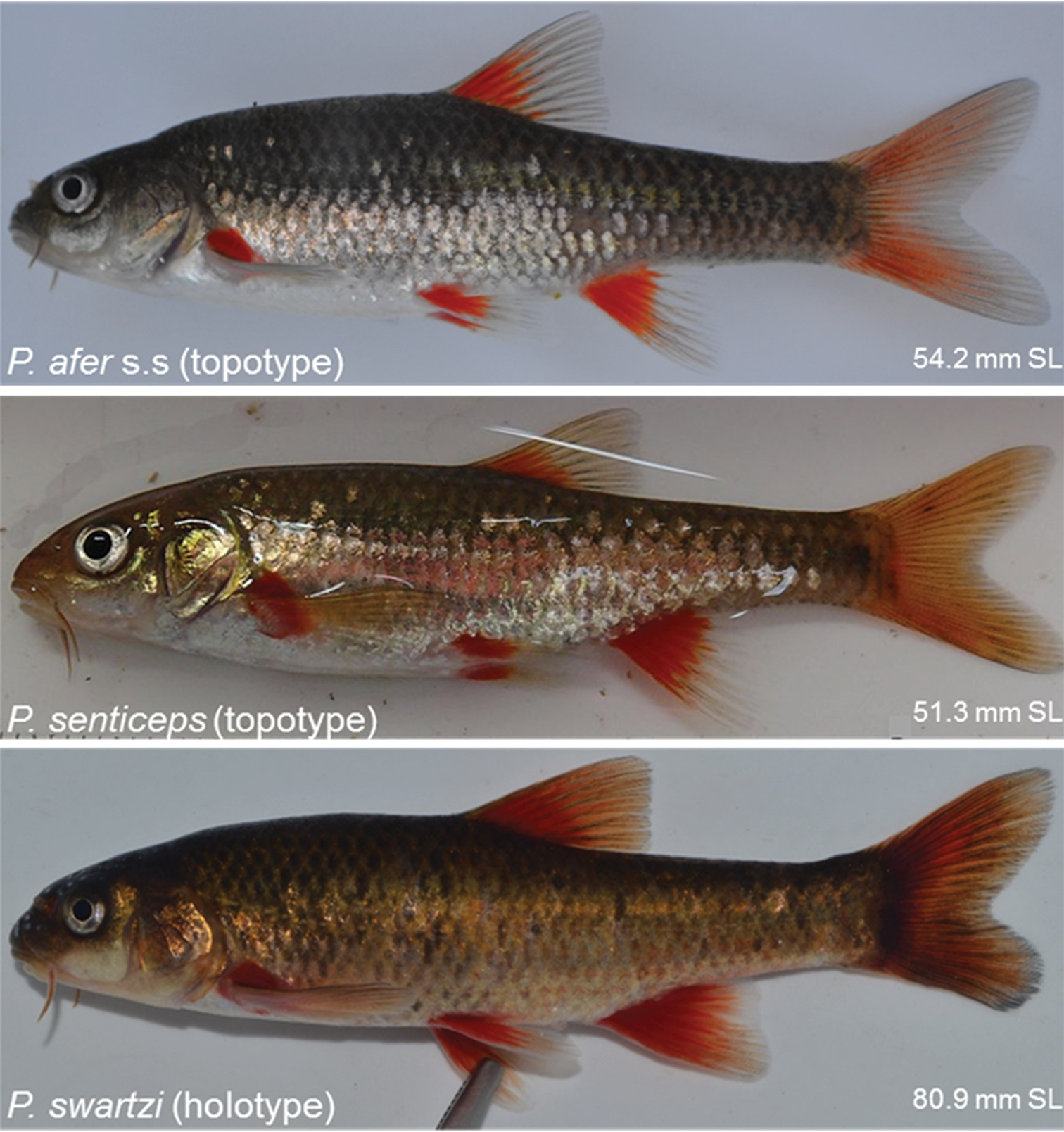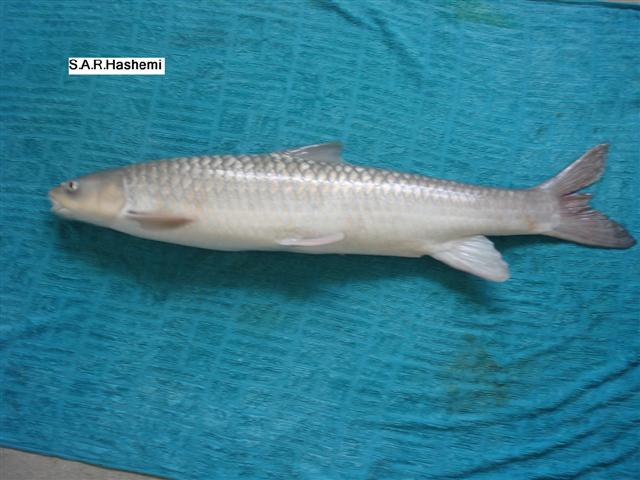|
Pseudobarbus Swartzi
''Pseudobarbus'' is a ray-finned fish genus in the family Cyprinidae. The type species is Burchell's redfin (''P. burchelli''). The scientific name is derived from the Ancient Greek ''pseudes'' ("false") and the Latin word ''barbus'' ("beard", in reference to the barbels of barbs). This genus contains some (and might contain all) of the South African redfins. It was originally proposed as a subgenus, but has since been found worthy of recognition as a full genus. This genus is restricted to southern Africa; all of its species were formerly placed in '' Barbus'', the genus of typical barbels and their relatives. One taxon was originally described as ''P. leonhardi'' – this, however, was a European fish for which the genus was erroneously proposed anew. It has since turned out to be nothing other than the barbel '' B. peloponnesius''.FishBase 009/ref> Species and systematics ''Pseudobarbus'' was placed in the paraphyletic In taxonomy (general), taxonomy, a ... [...More Info...] [...Related Items...] OR: [Wikipedia] [Google] [Baidu] |
Burchell's Redfin
Burchell's redfin (''Pseudobarbus burchelli''), also known as the Tradouw redfin, Tradou redfin or Breede redfin, is an African freshwater fish species in the family Cyprinidae. ''P. burchelli'' is the type species of its genus ''Pseudobarbus'', and like all of these is tetraploid. The Berg River redfin (''P. burgi'') is a very close relative. It is endemic to the Western Cape Province of South Africa, where it occurs in the Moeras and Tradouw Rivers. Whether the similar fishes from the Breede River and Heuningnes River are also ''P. burchelli'' is undetermined.Swartz & Impson (2007) Two populations are known with certainty, one in the Moeras River at Barrydale and one at the Tradouw River at Tradouw's Pass. During summer, low water levels cut off gene flow between these two. The species inhabits deeper sections of the rivers' somewhat peaty water. Other fish are rare, and in Burchell's redfin's range these seem to consist of the introduced bluegill (''Lepomis macrochirus'') ... [...More Info...] [...Related Items...] OR: [Wikipedia] [Google] [Baidu] |
Barbel (fish)
Barbels are group of small carp-like freshwater fish, almost all of the genus ''Barbus''. They are usually found in gravel and rocky-bottomed slow-flowing waters with high dissolved oxygen content. A typical adult barbel can range from 25 to 100 cm in length and weigh between 200 g and 10 kg, although weights of 200 g are more common. Babies weigh 100–150 g. Barbel roe is poisonous and causes vomiting and diarrhea in some people. However, the fish itself can be eaten and recipes are available in The Illustrated London Cookery Book by Frederick Bishop. The name barbel derived from the Latin ''barba'', meaning beard, a reference to the two pairs of barbels, a longer pair pointing forwards and slightly down positioned, on the side of the mouth. Fish described as barbels by English-speaking people may not be known as barbels in their native country, although the root of the word may be similar. For instance, the Mediterranean barbel (''Barbus meridionalis'') ... [...More Info...] [...Related Items...] OR: [Wikipedia] [Google] [Baidu] |
Pseudobarbus Burchelli
Burchell's redfin (''Pseudobarbus burchelli''), also known as the Tradouw redfin, Tradou redfin or Breede redfin, is an African freshwater fish species in the family Cyprinidae. ''P. burchelli'' is the type species of its genus ''Pseudobarbus'', and like all of these is tetraploid. The Berg River redfin (''P. burgi'') is a very close relative. It is endemic to the Western Cape Province of South Africa, where it occurs in the Moeras and Tradouw Rivers. Whether the similar fishes from the Breede River and Heuningnes River are also ''P. burchelli'' is undetermined.Swartz & Impson (2007) Two populations are known with certainty, one in the Moeras River at Barrydale and one at the Tradouw River at Tradouw's Pass. During summer, low water levels cut off gene flow between these two. The species inhabits deeper sections of the rivers' somewhat peaty water. Other fish are rare, and in Burchell's redfin's range these seem to consist of the introduced bluegill (''Lepomis macrochirus'') ... [...More Info...] [...Related Items...] OR: [Wikipedia] [Google] [Baidu] |
George Albert Boulenger
George Albert Boulenger (19 October 1858 – 23 November 1937) was a Belgian-British zoologist who described and gave scientific names to over 2,000 new animal species, chiefly fish, reptiles, and amphibians. Boulenger was also an active botanist during the last 30 years of his life, especially in the study of roses. Life Boulenger was born in Brussels, Belgium, the only son of Gustave Boulenger, a Belgian public notary, and Juliette Piérart, from Valenciennes. He graduated in 1876 from the Free University of Brussels with a degree in natural sciences, and worked for a while at the Royal Belgian Institute of Natural Sciences, Brussels, as an assistant naturalist studying amphibians, reptiles, and fishes. He also made frequent visits during this time to the ''Muséum national d'Histoire naturelle'' in Paris and the British Museum in London. In 1880, he was invited to work at the Natural History Museum, then a department of the British Museum, by Dr. Albert C. L. G. Günther a ... [...More Info...] [...Related Items...] OR: [Wikipedia] [Google] [Baidu] |
Pseudobarbus Asper
The smallscale redfin ('Pseudobarbus asper'') is a freshwater fish in the family Cyprinidae which is endemic to South Africa. It is threatened by habitat destruction and the impact of invasive species. Description Its meristic data are that there are three-four dorsal fin spines and 7 rays while the nail fin has three spines and five rays and the lateral line has 37-40 small scales. It has a single pair of barbels and the males develop dark red fins and tubercules on the head when breeding. It grows to around 12 cm total length. Distribution ''Pseudobarbus asper'' occurs in the arid Karoo region of South Africa in the Gamtoos and Gourits River systems of the Eastern Cape in South Africa. Biology The smallscale redfin is found in turbid, eutrophic waters which have soft silty beds or over boulders to boulder in the Karoo region of South Africa. Its small size is understood to be an adaptation to the highly variable environment this fish inhabits, making it able to exploit ... [...More Info...] [...Related Items...] OR: [Wikipedia] [Google] [Baidu] |
Wilhelm Peters
Wilhelm Karl Hartwich (or Hartwig) Peters (22 April 1815 in Koldenbüttel – 20 April 1883) was a German natural history, naturalist and explorer. He was assistant to the anatomist Johannes Peter Müller and later became curator of the Natural History Museum, Berlin, Berlin Zoological Museum. Encouraged by Müller and the explorer Alexander von Humboldt, Peters travelled to Mozambique via Angola in September 1842, exploring the coastal region and the Zambesi River. He returned to Berlin with an enormous collection of natural history specimens, which he then described in ''Naturwissenschaftliche Reise nach Mossambique... in den Jahren 1842 bis 1848 ausgeführt'' (1852–1882). The work was comprehensive in its coverage, dealing with mammals, birds, reptiles, amphibians, river fish, insects and botany. He replaced Martin Lichtenstein as curator of the museum in 1858, and in the same year he was elected a foreign member of the Royal Swedish Academy of Sciences. In a few years, he g ... [...More Info...] [...Related Items...] OR: [Wikipedia] [Google] [Baidu] |
Pseudobarbus Afer
The Eastern Cape redfin (''Pseudobarbus afer'') is an African freshwater fish species in the family (biology), family Cyprinidae, this appears to be a species complex rather than a single species. It is endemism, endemic to the Sundays River, Sundays, Swartkops River, Swartkops and Baakens River, Baakens river systems of the Eastern Cape, South Africa, the fish in other rivers in the region have been suggested to belong to different species with four different lineages recognised, a forest lineage which appears to be more closely related to ''Pseudobarbus phlegethon'' of the Olifants River (Western Cape), Olifants River than the other lineages traditionally classified within ''P. afer'', the other lineages are the "St Francis" lineage which occurs in the rivers flowing into St Francis Bay and has been given the name ''Pseudobarbus swartzi'', the Krom lineage ''Pseudobarbus senticeps'' from the Krom River system and the "Mandela" lineage ''Pseudobarbus afer'' ''sensu stricto''. Al ... [...More Info...] [...Related Items...] OR: [Wikipedia] [Google] [Baidu] |
Animal Biology (journal)
''Animal Biology'' is a peer-reviewed scientific journal in the field of zoology. It is the official journal of the Koninklijke Nederlandse Dierkundige Vereniging (Royal Dutch Zoological Society) and published on behalf of the society by Brill Publishers. The journal was established in 1872 as the ''Archives Néerlandaises de Zoologie'' and renamed ''Netherlands Journal of Zoology'' in 1967. It has been known under its current name since 2004. Abstracting and indexing According to the ''Journal Citation Reports'', the journal's 2010 impact factor is 0.879 and it is indexed in BIOSIS, CABS, Current Contents/Agriculture, Biology and Environmental Sciences, FISHLIT, GeoAbstracts,'' ''Science Citation Index,'' and ''Scopus Scopus is Elsevier's abstract and citation database launched in 2004. Scopus covers nearly 36,377 titles (22,794 active titles and 13,583 inactive titles) from approximately 11,678 publishers, of which 34,346 are peer-reviewed journals in top-l ....'' Refere ... [...More Info...] [...Related Items...] OR: [Wikipedia] [Google] [Baidu] |
Cyprininae
The Cyprininae are one of at least 11 subfamilies of cyprinid fish. It contains three genera in its strictest definition but many more are included depending on which authority is defining it, especially if the Labeobarbinae is not considered to be a valid grouping. Recognized genera * '' Arabibarbus'' (3 species) * ''Barboides'' (2 species) * ''Barbonymus'' (tinfoil barbs) (10 species) * ''Capoeta'' (35 species) * ''Carassioides'' (4 species) * ''Carassius'' (5 species) * ''Cyprinus'' (24 extant and 1 fossil species) * ''Eechathalakenda'' (Channa barb) * ''Gymnocypris'' (10 species) * ''Labeobarbus ''Labeobarbus'' is a mid-sized ray-finned fish genus in the family Cyprinidae. Its species are widely distributed throughout eastern Africa and especially southern Africa, but also in Lake Tana in Ethiopia. A common name, in particular for the s ...'' (126 species) * '' Paraqianlabeo'' (1 species) References *Phylogeny of the subfamily cyprininae (Pisces: Cyprinidae), Z ... [...More Info...] [...Related Items...] OR: [Wikipedia] [Google] [Baidu] |
Subfamily
In biological classification, a subfamily (Latin: ', plural ') is an auxiliary (intermediate) taxonomic rank, next below family but more inclusive than genus. Standard nomenclature rules end subfamily botanical names with "-oideae", and zoological names with "-inae". See also * International Code of Nomenclature for algae, fungi, and plants * International Code of Zoological Nomenclature * Rank (botany) * Rank (zoology) In biological classification, taxonomic rank is the relative level of a group of organisms (a taxon) in an ancestral or hereditary hierarchy. A common system consists of species, genus, family, order, class, phylum, kingdom, domain. While ... Sources {{biology-stub ... [...More Info...] [...Related Items...] OR: [Wikipedia] [Google] [Baidu] |
Paraphyletic
In taxonomy (general), taxonomy, a group is paraphyletic if it consists of the group's most recent common ancestor, last common ancestor and most of its descendants, excluding a few Monophyly, monophyletic subgroups. The group is said to be paraphyletic ''with respect to'' the excluded subgroups. In contrast, a monophyletic group (a clade) includes a common ancestor and ''all'' of its descendants. The terms are commonly used in phylogenetics (a subfield of biology) and in the tree model of historical linguistics. Paraphyletic groups are identified by a combination of Synapomorphy and apomorphy, synapomorphies and symplesiomorphy, symplesiomorphies. If many subgroups are missing from the named group, it is said to be polyparaphyletic. The term was coined by Willi Hennig to apply to well-known taxa like Reptilia (reptiles) which, as commonly named and traditionally defined, is paraphyletic with respect to mammals and birds. Reptilia contains the last common ancestor of reptiles a ... [...More Info...] [...Related Items...] OR: [Wikipedia] [Google] [Baidu] |


